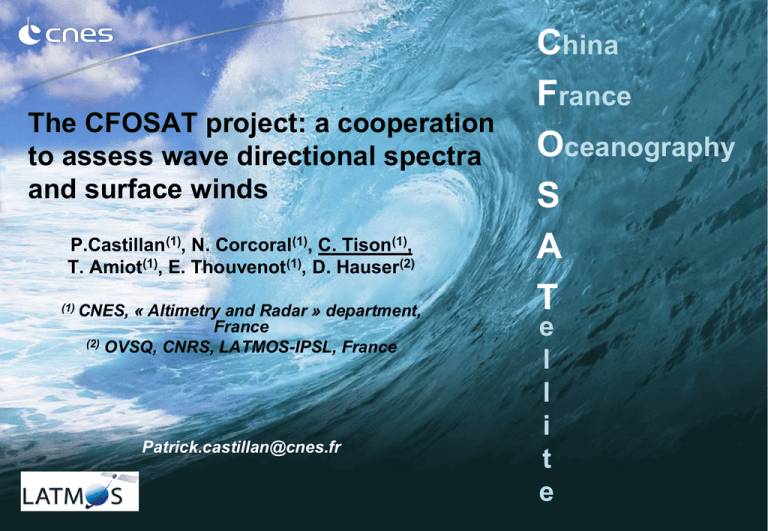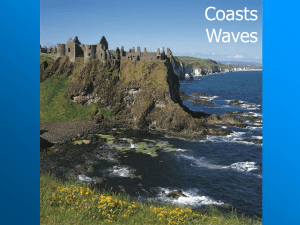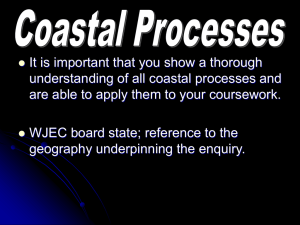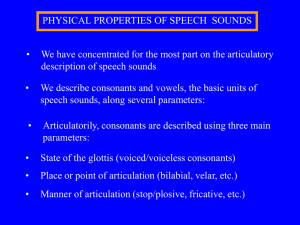CFOSAT
advertisement

The CFOSAT project: a cooperation to assess wave directional spectra and surface winds P.Castillan(1), N. Corcoral(1), C. Tison(1), T. Amiot(1), E. Thouvenot(1), D. Hauser(2) (1) CNES, « Altimetry and Radar » department, France (2) OVSQ, CNRS, LATMOS-IPSL, France Patrick.castillan@cnes.fr China France Oceanography S A T e l l i t e Summary ►What is the CFOSAT mission? ►Mission objectives ►Description ►Focus of CFOSAT on the SWIM instrument 2 The CFOSAT mission SWIM SCAT ►CFOSAT: an innovative China/France mission for oceanography ►Joint measurements of oceanic wind and waves SWIM: a wave scatterometer (new instrument) SCAT: a wind scatterometer (fan beam concept) This mission is a “world première” ►SWIM, new spaceborne instrument with technology innovations (antenna, on-board digital processing) ►SCAT, new concept of wind scatterometer ►Access to 2D wave spectrum with high angular resolution and with global scale ►Joint measurements of winds and waves 3 The CFOSAT mission ►CFOSAT ►CFOSAT is: a scientific mission for public services (Meteorology agencies, research centers, marine agencies, etc.) a demonstration and pre-operational mission (for Météo France, EUMETSAT, CEPMMT, etc.) adds: a new component to spatial oceanography systems assimilation of CFOSAT data in meteorological models possible integration of CFOSAT wave measures in GMES/MyOcean, GlobWave. Spatial observations Models Forecast In situ observations 4 Key dates 2006 ►Signature of the Memorandum Of Understanding CFOSAT 2007- 2008 ►Phase A CFOSAT Feasibility demonstration 2009-2010 ►Phase B CFOSAT Preliminary design 2011-2014 ►Phases C/D CFOSAT Detailed design Manufacturing of flight model and qualification models 2015 ►Operational system in orbit Launch from China (end of 2014) 5 A China/France cooperation Principal Investigators D.Hauser – CNRS/LATMOS Liu Jianqiang - NSOAS Launch / campaign CFOSAT system – science & data Satellite Satellite control Platform Stations CNSA/DFH CNSA SWIM CNES Contract : Thales Alenia Space Operations / Mission X-band stations CNSA/NSOAS Control center CNSA Chinese mission center CHOGS CNSA/NSOAS SCAT CNSA/CAS (CSSAR) Polar X-band stations Network CNES Contract : SSC CNSA X-band TM CNSA/CNES Contract : Thales Alenia Space Operations CNSA French mission center FROGS CNES/IFREMER 6 Scientific objectives ►Global observation of ocean wind and waves with high temporal coverage ►Why? To improve wind and wave forecast and sea-state monitoring To improve the knowledge and the modeling of sea-surface processes To get a simultaneous wind and wave measures for coupling effects characterization Waves generation by local winds Free propagation (swell) Bathymetry impact Coastal wave breaking ►Secondary objectives (for SWIM) Land surface monitoring (soil moisture and soil roughness) Polar ice sheet characteristics 7 CFOSAT goals ►Sea state conditions have great impact on: Commercial activities: marine transport and offshore activity (oil platform) Pollution transport Security at sea and in coastal areas Biology and sediment transport Sea-ice formation/destruction Gas exchange (CO2), stress over the ocean, heat fluxes Sea color (Albedo) ►Wind and waves measures are mandatory for weather forecast and climate survey. 8 Scientific requirements ►Mission Minimum duration of 3 years Global coverage over the oceans (polar orbit) Data available in near-real time ►SWIM Directional wave spectra from incidences 6° to 8° To be measured in the wavelength range 70m-500m With a 10% accuracy on wavelength, 15° accuracy on wave propagation direction With a 15% accuracy on spectral level around the peak of the spectrum Significant wave height and wind speed from nadir 10% on SWH (or 50 cm whichever is better) rms <2 m/s on wind speed Normalized radar cross-section form 0 to 10° Absolute accurcay of ±1 dB Relative accuracy between incidences ± 0.1 dB ►SCAT Wind vector Wind speed range and precision: 2m/s or 10% (larger) @5~24m/s Wind direction precision: 20 ° Backscattering coefficient precision : 0.5dB Surface resolution 50km (standard product) 25km(experimental product) 9 Payloads ►Two scientific payloads SWIM: Surface Waves Investigation and Monitoring SCAT: wind SCATterometer ►SWIM Surface Waves Investigation and Monitoring Real aperture radar in Ku-band 6 incidence angles: 0°, 2°, 4°, 6°, 8° et 10° Antenna diameter: 90 cm (~2° aperture) Polarization VV Rotation speed: 5.7 rpm Power: 120 W Useful bandwidth: 320MHz Pulse duration: 50 µs PRF: 2 - 7 kHz 10 Payloads ►Two scientific payloads SWIM: Surface Waves Investigation and Monitoring SCAT: wind SCATterometer Rotating fan beam antenna ►SCAT Flig h Wind SCATterometer Real aperture radar in Ku-band t di rec tion Nadir point Fan beam concept Incidence angles (on ground): 20°-65° Surface footprint ath Sw Antenna size: 1.2mx0.4m Alternate polarization: HH-VV Rotation speed: 3.2 rpm Power: 120 W Useful bandwidth: 0.5 MHz © CSSAR/CAS 11 Satellite ►Orbit Sun synchronous Local time at descending node AM 7:00 Altitude at the equator 519 km Cycle duration 13 days ►Mass and dimensions Mass ~600 kg Primary structure ~1.5mx1.5mx1.5m 12 CFOSAT Movie 13 Ground system Inuvik Kiruna Mudanjiang IWWOC – Waves & Wind Mission Center Brest CWWIC Instruments Mission Center Toulouse Control center S-band network Xi’an Beijing Sanya Chinese Mission Center Beijing Users Worldwide 14 15







